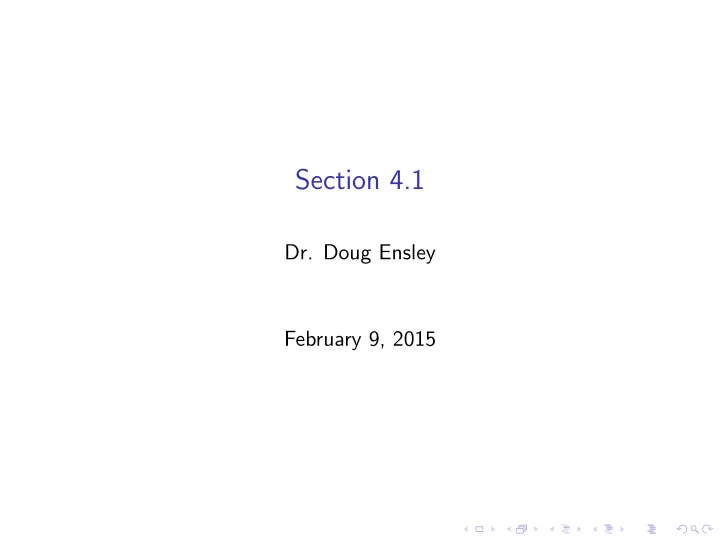

Section 4.1 Dr. Doug Ensley February 9, 2015
Linear Functions A linear function’s defining property is that the slope between any two points is the same.
Linear Functions A linear function’s defining property is that the slope between any two points is the same. Example 1 Is this data from a function that’s linear or nonlinear? If linear, what is the slope? x 1 2 5 6 8 y = f ( x ) 20 17 8 5 -1
Linear Functions A linear function’s defining property is that the slope between any two points is the same. Example 1 Is this data from a function that’s linear or nonlinear? If linear, what is the slope? x 1 2 5 6 8 y = f ( x ) 20 17 8 5 -1 In this example, no matter what two points you use, the slope between them is − 3. Therefore, these points are consistent with a linear function with slope − 3.
Linear Functions A linear function’s defining property is that the slope between any two points is the same.
Linear Functions A linear function’s defining property is that the slope between any two points is the same. Example 2 Is this data from a function that’s linear or nonlinear? If linear, what is the slope? x 0 1 3 4 6 y = g ( x ) 20 17 8 5 1
Linear Functions A linear function’s defining property is that the slope between any two points is the same. Example 2 Is this data from a function that’s linear or nonlinear? If linear, what is the slope? x 0 1 3 4 6 y = g ( x ) 20 17 8 5 1 This function is non-linear. For example. the slope between points (0 , 20) and (1 , 17) is − 3, but the slope between (1 , 17) and (4 , 5) is − 4.
Linear Functions
Linear Functions (a) Slope is 1 4 and y -intercept is the point (0 , − 3)
Linear Functions (a) Slope is 1 4 and y -intercept is the point (0 , − 3) (c) Average rate of change is the same as slope, so 1 4
Linear Functions (a) Slope is 1 4 and y -intercept is the point (0 , − 3) (c) Average rate of change is the same as slope, so 1 4 (d) Slope is positive so this function is always increasing.
Linear Functions
Linear Functions (a) f ( x ) = 0 when x = 3 2 . This means the x -intercept of f is at � 3 � the point 2 , 0 .
Linear Functions (a) f ( x ) = 0 when x = 3 2 . This means the x -intercept of f is at � 3 � the point 2 , 0 . (b) f ( x ) > 0 when x > 3 2 . That is, f ( x ) > 0 for all x in the � 3 � interval . 2 , ∞
Linear Functions (a) f ( x ) = 0 when x = 3 2 . This means the x -intercept of f is at � 3 � the point 2 , 0 . (b) f ( x ) > 0 when x > 3 2 . That is, f ( x ) > 0 for all x in the � 3 � interval . 2 , ∞ (c) f ( x ) = g ( x ) is the same thing as 6 x − 9 = − 8 x + 5, which happens when x = 1. This means that the two functions have the same y -value when x = 1.
Linear Functions (a) f ( x ) = 0 when x = 3 2 . This means the x -intercept of f is at � 3 � the point 2 , 0 . (b) f ( x ) > 0 when x > 3 2 . That is, f ( x ) > 0 for all x in the � 3 � interval . 2 , ∞ (c) f ( x ) = g ( x ) is the same thing as 6 x − 9 = − 8 x + 5, which happens when x = 1. This means that the two functions have the same y -value when x = 1. (d) f ( x ) ≤ g ( x ) when x ≤ 1. That is, f ( x ) ≤ g ( x ) for all x in the interval ( −∞ , 1).
Intersection of Two Lines (e) We use part (c) and the fact that f (1) = g (1) = − 3 to determine that the intersection point is (1 , − 3).
Linear Functions
Linear Functions (a) The linear function should satisfy V (0) = 1800 and V (6) = 0, so the function is V ( x ) = 1800 − 300 x for 0 ≤ x ≤ 6. (b) The interval [0 , 6].
Recommend
More recommend